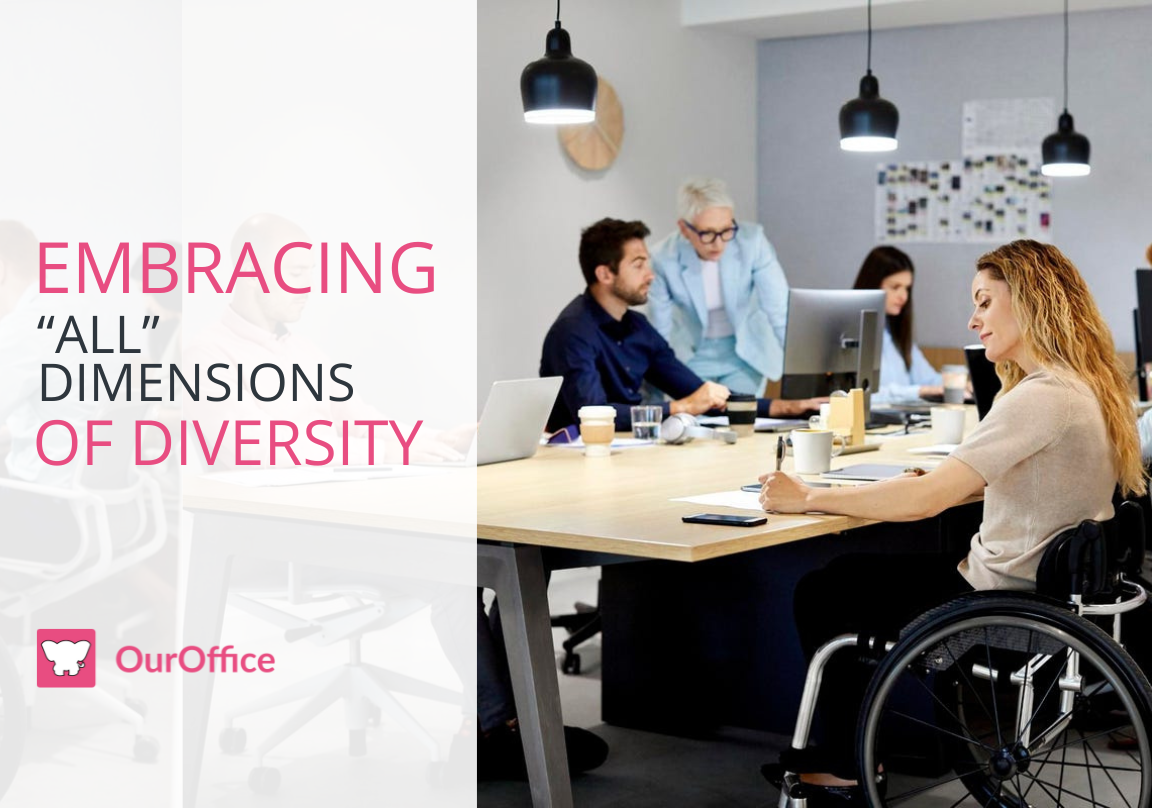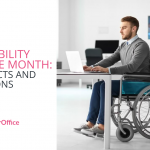21 Nov Embracing “All” dimensions of diversity

Often we focus on the typical diversity categories: gender, sexual orientation, race/ethnicity, and disability. In this piece, we want to talk about other important dimensions of diversity that are often forgotten such as, Veteran Status, Age, People with Criminal Records, and Religion.
Veterans in the Workplace
Each November in the United States, we celebrate and honor our veterans who served to protect us. According to the U.S. Bureau of Labor and Statistics report, in 2021 there were 18.5 million men and women who were veterans, accounting for about 7 percent of the civilian population aged 18 and over. Currently, veterans are more likely to find jobs than their civilian peers in sectors like manufacturing (12% for veterans vs. 9% for non-veterans) and transportation (8% vs. 5%) but less likely to work in education and health (9% vs. 16%) and retail trade (8% vs. 10%).
This year, research from the University of Cincinnati School of Business shows that many military veterans returning to the workplace face the stigma of negative stereotypes. kerio control UC's research found that veterans faced a perplexing paradox of equally unwelcome extremes of co-workers, managers, or civilian peers putting them on pedestals or pigeonholing them in a harmful way because of their service. Study participants reported that many of their co-workers assumed they had been in combat or shot people, and many believed they had post-traumatic stress disorder. As in many ways we talk about diversity, it is important not make assumptions about others or attempt to associate your unrelated experience, but to listen, learn and acknowledge everyone's individual story.
During the OurOffice Future of Work Roundtable discussion, Laura Hanchett, Vice President, Employee Benefits USI Insurance Services LLC shared, “a lot of leaders want diversity, but people often are not aware of the biases that are present when it comes to diversity.” Everyone has unconscious biases that they bring with them to the workplace and it can be challenging to navigate acknowledging these biases. Training on unconscious bias is often the first step organizations take to address this concern but one training cannot change the workplace culture overnight. Glenda Williams, Director of Diversity and Inclusion at AM General shared, “ we have attended training, many of us have gone to several over the years, but we need to find ways to keep the discussion top of mind every day.”
 Ageism in the Workplace
Ageism in the Workplace
Many organizations seek to recruit Millennials and Gen Z employees and as a result, more seasoned employees feel that they are being pushed out or forgotten in the workplace.
Some 78% of workers aged 40 to 65 say they’ve seen or experienced ageism in the workplace, according to a 2021 AARP survey. Generational labels and societal views, as well as older workers’ ageism fears, can all fuel a negative environment for older
workers, experts say. But by making age part of overall diversity efforts, HR can fight ageism and make their workplace more representative of the general population. There is tremendous value in multiple generations learning from each other and engaging with each other with a tendency for multigenerational workforces to be more productive and have creative employees and less turnover.
During the OurOffice Roundtable discussion, leaders agreed that they are working hard to diversify their workforce and have a better balance between younger and older employees. Each generation values different things about work and what they need from their employer. So recruiting and retaining employees from multiple generations can be difficult. Camille Bryant, Chief Diversity Officer at Walker Miller Energy Services shared that it is important to “think about what good looks like in DEI for all the business functions.” Indeed diversity looks different for each organization and it is important to identify your organization's goals as it relates to your industry.
Persons with Criminal History
It is estimated that nearly 80 million people in the U.S. have a criminal record of some sort, that is over one-third of the adult population. Yet despite the growing need among U.S. employers for workers, applicants with criminal records often face huge obstacles to achieving gainful employment.
Today, many employers are finding that the best approach to hiring individuals with criminal backgrounds is not so different from the hiring approach they use for everyone else: to evaluate each candidate on his or her merits.
SHRM research found that:
- 2 in 3 HR professionals said their organization has hired individuals with criminal records.
- 85% of HR professionals believe workers with criminal records perform their jobs about the same or better than workers without criminal records.
- 81% of HR professionals felt the cost-per-hire of workers with criminal records was about the same or less than workers with criminal records
- 75% of HR professionals said workers with criminal records were just as or more dependable than workers without criminal records.
During the OurOffice Future of Work Roundtable discussion, leaders agreed that in most organizations, persons with previous convictions should be considered as part of the overall hiring strategy, but it depends on the role they are applying for. The good news is that DEI leaders are already rethinking what background and skills are really required for each role when writing job descriptions in their postings to attract a more diverse applicant pool.
 Religious Diversity
Religious Diversity
We tend to think of business as a secular activity, and workplaces as inappropriate settings for conversations about religious faith or observance. However, given the growing popularity of bringing one’s whole self to work, the trend towards practices such as yoga and mindfulness, and the fact that more than 80% of the world claims some sort of religious affiliation, leaders are increasingly concerned about how best to handle expressions of faith by their employees.
During the OurOffice Future of Work Roundtable, this topic sparked a great discussion Sonya Sepahban, CEO of OurOffice, reminded the group that the demographics in America in terms of religion are changing. While 60% of people in the U.S. are Christian, there is still another 40% of persons practicing other religions. In the workplace, we have to think about acknowledging those differences, especially when it comes to considering time off for religious observations, and hosting holidays events by organizations.
For many religious people, their faith is associated with deeply held values that inform their actions and behaviors at work as well as in their personal lives. In workplaces where employees feel comfortable talking about their religious beliefs, everyone can gain a richer understanding of their colleagues’ personal motivations and of the varied values at play in their organizations. It is vital to offer training to all employees and to discuss what is acceptable in terms of discussing faith in the workplace. Employees may try to impose their belief systems on others without even realizing it. Encourage employees to accept differences. While the perception is that many religions are directly opposed to one another, common ground can be reached once acceptance occurs.
Camille Bryant agrees that religious diversity is an area that she wants to expand her focus. “We want to create a safe space for all religions where they feel safe and included. We recently hosted an event to share about different religions and it was well attended. We realized how many similarities exist between religions”.
Many organizations are taking steps to expand their view of diversity and are beginning to offer prayer or meditation rooms to allow employees to practice their religion throughout the day. In addition, employers have become open to providing time off to employees for religious reasons outside of the most commonly celebrated days. Camille shared that her organization is looking to launch floating holiday options for employees to use for cultural/religious holidays they wish to celebrate, “ Right now we only have one floating holiday that some folks use for Good Friday, but we realize that it may be time to expand this offering, although it is hard to balance scheduling to ensure the company needs are met”. Religious diversity is a benefit to the workplace, and it also impacts how businesses interface with those outside the office, including clients, partners, and others in their field. The more diverse the workforce, the better equipped it is to deal with a wider public.
Overall, the research shows that it is time to explore beyond the typical diversity identifiers of race, gender, and sexual orientation to advance DEI work. Organizations seek to recruit and retain employees at a time when many people have several intersections of diversity. During the OurOffice Roundtable discussion, Laura Hanchett shared her thoughts on how to advance DEI efforts within organizations. “I see that executives that are measured and compensated based on the diversity they have in the organization are very invested in DEI and integrating it in all functions of the business”. Whether it is veteran status, age, persons with previous convictions, or religion, dimensions of diversity can evolve over time and it is critical that employers create a workplace environment that is psychologically safe and celebrates the diversity of all employees.




